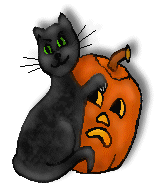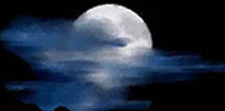


Family Network


|


Family Network


|
|
History of Witchcraft, Witches Around The World.

 Halloween in Ireland/Celtic
They were worried that the sun would not return so to make sure it did they held a festival on October 31. During which, they asked the sun to return safely in the summer. All the cooking fires were put out and a huge bonfire was lit on the hillside. Here they prayed the sun would shine brightly after winter was over.
The next morning they would return to the hillside take a piece of the burning wood from the remains of the bonfire and light new fires so as to bring good luck. Feasts were held over the new fires and people would dress up in costumes made out of animal skins. It was believed these costumes would protect people from bad luck.
This is how Hallowe'en is said to have begun and is still celebrated today.
Cats were considered by the Celts too be spirits and that cats could predict the future.
In Ireland the black cat was considered to be bad luck and if it crosses your path while walking or crosses the threshold of your home or ship it was considered bad luck.
In Ireland children would cut scary faces into hollowed-out turnips, large rutabagas, or potatoes. Then place and candle inside them.
Children once enjoyed throwing cabbages and turnips at doors at Hallowe'en time. Smashing bottles near windows was also done in fun.
The Celts referred to Halloween as The Samhain Festival. It was during this time that you would lead your livestock home from summer pastures to the winter shelters. Samhain Eve was a time when the veil between the worlds of the living and the dead grew thinner, and ghosts ventured toward the warmth if people's homes and hearths. On the Eve the Celts built bonfires in memory of their departed ancestors and left food and drink on their tables overnight for eating by the ghosts.
The tenth-century abbot of Cliny Odile changed Samhain's name to All Saints' Day. October 31 became All Hallows' Eve or Hallowes' Even, and eventually would become Halloween. Halloween is now for the children, whose practice of trick-or-treating has its roots in the English custom of "soul-caking". From medieval times onward poor people would beg door-to-door for spiced cakes that the householders would award as payment for prayers the beggars promised to say for the householders' ancestors. This song was referred to as the soul-cakers song.
In Ireland they continued to practice their deep-rooted, ancient pagan rites well after the arrival of Christianity in the middle of the sixth century. The Church fathers had become concerned that the popularity of non-Christian festivals was growing at the expense of Christian holy days.
Pope Gregory I, in 601 issued a decree to his missionaries about the faith and customs of the people whom he wanted to convert to Christianity. Gregory knew that it would be impossible to eradicate the beliefs of the natives totally and so suggested to his priests that they "convert" them whenever possible.
If the native people worshipped at a well, or sacred grove, Gregory informed his missionaries to enshrine them to Christ and let the worship continue.
Gregory's successor Pope Boniface IV in 609, declared May 13 All Saints' Day. Unfortunately, while pagans were happy to add All Saints' Day to their calendar, they were unwilling to give up their existing festival of the dead and continued to celebrate Samhain.
Intent on eliminating the ongoing power of the pagan beliefs, Pope Gregory III followed in the footsteps of the earlier Christian leaders and intentionally united the Christian All Saints' Day to the festival of Samhain. He then moved All Saints' Day to November 1, which became more commonly known as All Hallows. Because Samhain had traditionally fallen the night before All Hallows, it eventually became known as All Hallows' Even' or Hallowe'en.
Previous church leaders to Gregory III discouraged the Samhain tradition of wearing frightening costumes, but Gregory decided instead to allow people to dress up in honor of the saints. Other traditions, such as begging for food and kindling, were made legal by the Church, providing that any food that was given to the beggars would be given to the poor, rather than to appease the spirits.
The Church also added a second day to the festival, this fell on November 2 and was called All Souls' Day and was dedicated to the souls of those who are still left in purgatory. These souls had to endure the punishment of purgatory for their sins. It was believed that the lighting of candles and the saying of prayers for the dead would shorten the time they were to suffer in purgatory before they would rise to heaven.
  
Mens.Net | Womens.Net | Mothers.Net | Fathers.Net | Grandparents.Net | Teenagers.Net | Santas.Net | EasterBunnys.Net | JackOLanterns.Net | FatherTimes.Net | StValentines.Net HarvestFestivals.Net | BirthdayCelebrations.Net | ToothFairys.Net
 Please read our Legal Statement and Privacy Policy.
|